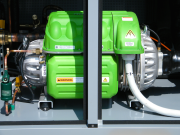
Growing international momentum against the use of HFC refrigerants has prompted a surge in UK demand for and interest in low Global Warming Potential (GWP) options, such as propane R290 and HFOs, according to cooling specialist Klima-Therm.
The company reports a significant increase in orders and enquiries for alternatives to HFCs following the F-Gas review in Europe and the recent US announcement of a ban on high GWP HFCs in chillers from the start of 2024. The US ban includes common mainstream refrigerants such as R134a, R410A and R407C.
Tim Mitchell, sales director of Klima-Therm (pictured), said: “It is clear that time is running out for HFCs. Given the scale of investment involved, end users considering major capital spend on new and replacement chillers simply can’t afford to be exposed. The history of refrigerant phase-outs teaches us that deadlines are almost always brought forward, as the industry readies itself ahead of planned changes.
He added: “This is now happening, and end users are seeking reassurance about plant longevity not just in mechanical terms, but in terms of legislation. With the trend now strongly against HFCs, or at least high GWP HFCs, it is rational to seek to future proof businesses, which explains the spike in enquiries about alternatives.”
Evidence of a swing away from HFCs is provided by a recent EU report, which reveals that HFC sales in Europe in 2015 declined by 29 per cent on the previous year. Stockpiling is thought to account for some of this, however a fall of nearly one third is unprecedented when not driven by a direct legal requirement.
Propane and HFO R1234ze have been a particular focus for Klima-Therm, with one high street retailer alone purchasing over 200 such machines to date. The chillers’ combined cooling capacity is just over 32MW, “sufficient to freeze over the lake in Regents’ Park”, suggests Mr Mitchell, “just to give you some idea of the scale of low GWP cooling we now have in operation across the country.”
With years of experience of servicing and maintaining these chillers in the field, the company reports that reliability is as good “if not better” than HFC machines, due to their more robust, industrial type build.
Mr Mitchell: “There is a growing recognition that the biggest restriction on growth in use of propane and other flammable refrigerants is not performance, reliability or safety issues, but the legislative framework on flammables that limits maximum charge size.”
A European Commission report, due to be published in January 2017, recommends that current restrictions on flammable refrigerants should be relaxed, to enable the EU to meet its carbon dioxide reduction targets, agreed under the recent Paris Climate Change Agreement.
EN378:2008 currently sets relatively restrictive flammable refrigerant charge size limits depending on system factors. However a 2014 revision to the ISO 817 standards established a new lower flammability category that will soon be mirrored in the forthcoming revision of EN378. The aim is to extend use of A2L refrigerants by allowing larger refrigerant charges subject to certain risk reduction measures being put in place. This would benefit HFOs but leave propane charges limited as now.